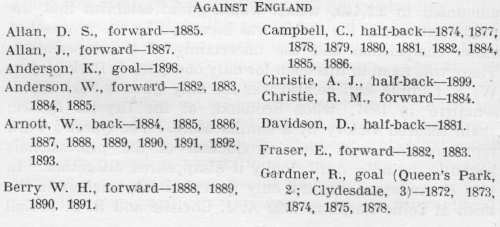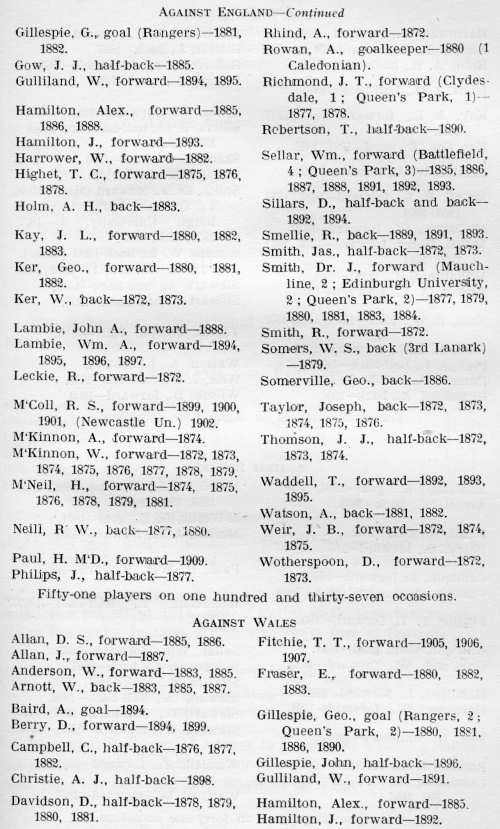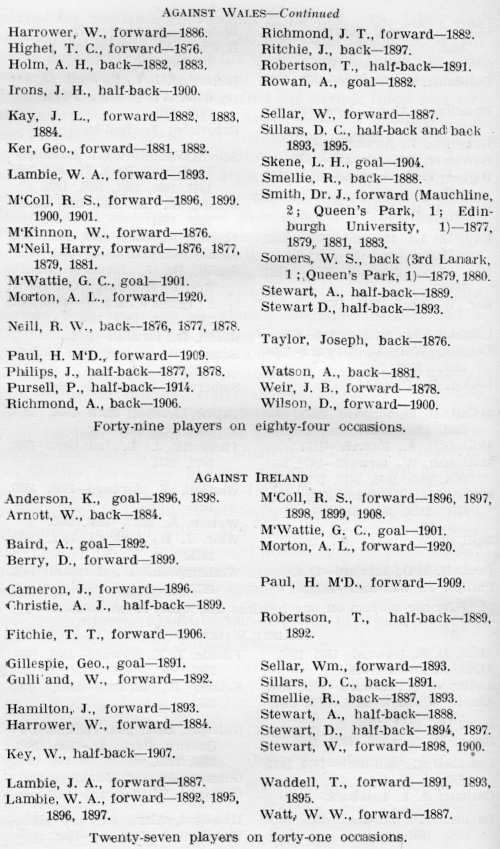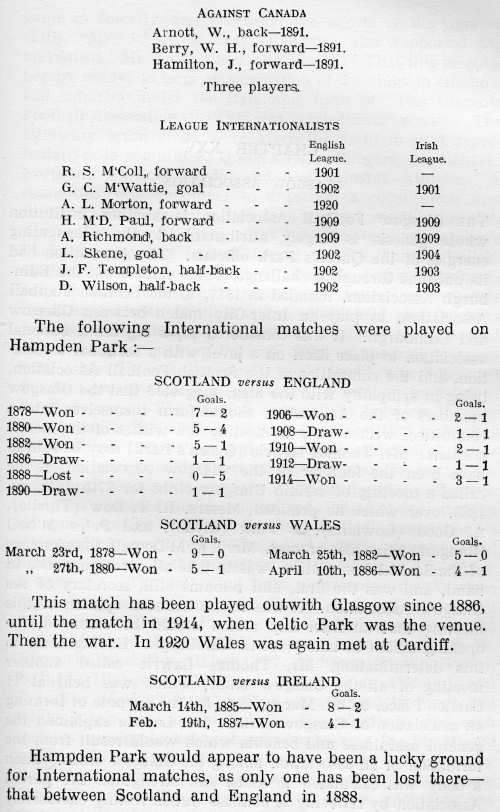As has been already explained, the first two
International matches recognised as official, were played under the auspices
of the Queen's Park alone. On both occasions Mr. R. Gardner, as captain, was
given by the club " full and sole power to select the Scottish
representatives," which he appears to have done satisfactorily. The first
International, at Partick, is dealt with in a special chapter. In the
second-game, played in 1873 in London, Mr. Gardner was met with a thin
purse, which compelled him to call upon the services of certain Scots in
London, to make up the full complement, with the seven men from Glasgow, all
the club could afford to pay fares for. These were R. Gardner, J. Taylor,
William Ker, J. J. Thomson, William M'Kinnon, D. Wotherspoon (Queen's Park),
W. Gibb (Clydesdale, also a member of Queen's Park, who had played for the
club-previously against the Wanderers), and the Anglo-Scots, James Smith
(Queen's Park, half-back, who then lived in London), Rennie Tailyour (Royal
Engineers), Hon. A. F. Kinnaird (Wanderers), and M. Blackburn (Royal
Engineers). The three strangers upset the Queen's Park as a combination, and
England won 4-2. It was many a long day ere England secured another
victory—not until 1879. When the International came into the hands of the
newly-formed Scottish Football Association, which was founded at the
instance of the Queen's Park, immediately after the second International in
March, 1873, naturally the representation became more widespread, and
Anglo-Scots had then no place in the team— all were of the home brand. The
Queen's Park players held pride of place in 1874, at Hamilton Crescent, with
seven players—Charles Campbell, J. B. Weir, H. M'Neil, and Angus M'Kinnon
being capped for the first time; J. Taylor, J. J. Thomson, and William
M'Kinnon making a third appearance. R. Gardner had by this time left Queen's
Park, and kept goal as a member of Clydesdale, but in this match J. J.
Thomson was captain, Gardner, as captain of Queen's Park, captaining the
first two games. In 1875, now that football had made vast strides since the
mighty deeds of the Queen's Park on the field of battle had called attention
to the game, and clubs were flocking to the standard of the Scottish
Football Association, the representation of the Queen's Park in the
International became reduced to five— J. Taylor (captain), J. B. Weir,
William M'Kinnon, H. M'Neil, and T. C. Highet; in 1876, at Hamilton
Crescent, the number came down to four—J. Taylor (captain), H. M'Neil,
William M'Kinnon, and T. C. Highet; in 1877, also to a quartette
- R. W. Neill, C. Campbell (captain). J. Philips and William M'Kinnon.
In this match were included two men who afterwards became famous as members
of the Queen's Park—namely, J. T. Richmond (Clydesdale) and John Smith (Mauchline).
The International was played on Hampden Park for the first time in 1878,
though that enclosure had been available now for five years, but the
question of terms between the club and the Scottish Football Association
could not be satisfactorily arranged. Five Queen's Park players were
selected—namely, C. Campbell (captain), J. T. Richmond (now a member of
Queen's Park), T. C. Highet, William M'Kinnon, and H. M'Neil. When England
won the match for the second time in 1879, there were only three Queen's
Park players in the team—C. Campbell (captain), William M'Kinnon, and H.
M'Neil. This was William M'Kinnon's eighth consecutive, and last,
International.
In the early 'eighties the Queen's Park stood at its
apogee as a force in football. In 1881 none of its three elevens lost a
match, while its subsequent mighty deeds in cup ties, Scottish and English,
especially in the latter competition, form episodes of which any club might
be proud. When it lost its grip of the Scottish Cup early in 1883, it made
up its mind to try for the English Cup, and how it all but succeeded twice,
is a most interesting part of its great history. Its representation in the
chief International at this period was strong, but then its fighting
capacity was great, and honours could not be denied the members of the team,
who were all unequalled in their day and generation as footballers, and the
names of some indeed are still outstanding in the history of the game. It is
a debatable point whether they have ever been . surpassed in their
respective positions in the field as exponents of the dribbling code. Take
such men as C. Campbell, a wonderful and evergreen half-back ; George Ker, a
prince among centre forwards; E. Fraser and W. Anderson, the greatest
combination of right-wing players ever seen; W. Arnott, than whom no better
back ever kicked a ball; J. L. Kay, a left-wing forward whose fame will
never die; W. Sellar, a truly great centre, a man of invincible
determination and resource, capped three times for Queen's Park, but had
previously played on four occasions against England as a member of
Battlefield. J. J. Gow, too, in combination with C. Campbell, made a
powerful defence in the days when two half-backs had to be of superior mould
to bear the burden of restraining six forwards. The men of this period
worthily maintained the record left to them by the heroes of the previous
decade, for the playing history of the club really dates from the opening of
first Hampden Park in 1873, or, to speak more correctly, from their first
"foreign" match against Wanderers in London in 1872, and the International
at Hamilton Crescent in the same year. Such players could not be ignored.
In the International of 1880, R. W. Neill, C. Campbell,
George Ker, and J. L. Kay found places. Archibald Rowan, then a member of
Caledonian, and afterwards a shining light in the Queen's Park team, stood
between the uprights in this game. In 1881, Andrew Watson, C. Campbell, D.
Davidson, Geo. Ker, and Harry M'Neil received recognition. This was Harry's
sixth and last "English" cap. He may be considered as included among the
great players of the 'seventies. With such a team as the Queen's Park
possessed at this time, that seven of its players are found in the
International of 1882 is by no means surprising. These were A. Watson, C.
Campbell, E. Fraser, W. Anderson, Geo. Ker, W. Harrower, and J. L. Kay. This
match was played on Hampden Park, and resulted in a pronounced victory for
the Thistle by 5-1, which was only to be expected from the weight of the
Scottish team. In the following year, 1883, when for the first time the
venue of the game, when played in England, was removed from the Oval to
Sheffield, the Fraser-Anderson combination was the observed of all
observers, and a revelation to the "Cutlers," while the work of Dr. John
Smith, who, though taking part in his fifth International, played now as a
member of the Queen's Park, was unsurpassed on any field, and his was the
winning goal in a victory by 3-2. Andrew H. Holm made his debut, and J. L.
Kay was the fifth Queen's Park representative in this match. Now enters what
may be styled the Arnott period, as that player began his series of ten
consecutive Internationals against England in 1884, when he now appeared as
a regular player in the Queen's Park team. Though he had been a member of
the club for two years, he played in cup ties and other games for his own
club—Poliokshields Athletic—as a rule, occasionally helping his new love. W.
Arnott, C. Campbell, W. Anderson (E. Fraser had gone to West Africa), R. M.
Christie, and Dr. Smith formed the Queen's Park contribution. This was a
game famous in Scottish football annals, in which Arnott, on Gathkin Park,
confounded the "Big Gunn," of Notts, Campbell assisting him. M'Aulay
(Dumbarton), the greatest of custodians, snatched the ball from the foot of
Bromley-Davenport in the goal-mouth—a daring and clever feat. Christie, who
died of wounds in May, 1918, in the Great War, made a most successful debut
here, while Dr. Smith and W. Anderson confounded the opposition. It was a
desperate struggle, the Scots being victorious by 1-0. In 1885, again back
to the Oval, half a dozen Queen's Parkers figure in the ranks—all good men
and true. C. Campbell and J. J. Gow appeared as a combination. W. Arnott, D.
S. Allan, W. Anderson, and Alex. Hamilton made up the remaining Queen's Park
contingent in this match. Renovated. Hampden Park housed this important
fixture in 1886. In the team were four Queen's Park players—W. Arnott, C.
Campbell, A. Hamilton, and Geo. Somerville. In this game England played
professionals in an International against Scotland for the first time, after
the latter had declined to play the match unless the English team consisted.
only of amateurs, but the Scottish Association gave way on the Football
Association making large concessions re the importation of Scots to
English clubs. This was Campbell's tenth and last International against
England—a great achievement, considering he was first capped in 1874, and
was yet worthy of the highest honours after twelve years' international
experience. In the series of thirteen Internationals in which Campbell took
part—ten against England and three against Wales—he was only once on the
losing side,. in 1879, when England won at the Oval by 5-4. Only three
players from the Queen's Park—W. Arnott, J. Allan, and A. Hamilton—took part
in the game played in 1887 on a mud hole at Blackburn, when the Scots won by
3-2. The team presented a terrible appearance after an hour and a half of
wading in dirt on Blackburn Rovers ground, and it was a hard and
ever-changing battle to the end.
In the late eighties the great professional question
raged, and Scotland held out stubbornly for many years against what was then
considered an evil, even after England had decided to recognise, and
legislate for, the professional player in i885. Veiled professionalism was
more than suspected at home, and some strange transfers of outstanding
players were made from provincial to city clubs. Celtic Football Club jumped
into the arena in full war ponoply, prepared to meet all comers in 1888, in
which year only three Queen's Park men took part in the International at
Hampden Park— W. Arnott, W. H. Berry, and J. A. Lambie. This was an
unfortunate game for Scotland, who lost by 5-0. The Thistle had not been
defeated since 1879— two games, those of 1885 and 1886 (both one goal each)
being drawn—and Hampden Park was the scene of the disaster. Three was also
the number from Queen's Park in 1889—R. Smellie, W. Arnott, and W. Berry ;
and ditto in 1890—W. Arnott, W. Berry, and Tom Robertson (late Cowlairs),
who afterwards bacame a famous referee, whose services were requisitioned
for important games all over the three kingdoms. In the beginning of the
'nineties the Queen's Park, as a team, despite the formation of the Scottish
League in that year, had many players of the first rank to uphold its fame,
and command the respect of the Scottish Association administrators. In 1891
William Sellar, late Battlefield, in whose colours he had obtained
International honours in 1885, 1886, 1887, and 1888, reappeared in the
Internationals as a Queen's Park player, this being his fifth cap against
England. An outstanding player as a centre forward, in this period he had no
equal. Arnott and R. Smellie were the backs in this match, and W. Berry the
fourth Queen's Park player in the team. The Scottish League in this season
would not allow its players to take part in the trial matches, not wishing
to disturb its fixture list, and only Heart of Midlothian and Vale of Leven,
of the League clubs, supported the Association. The League also that season
refused to permit its players to compete for the Charity Cup, and ran a
charity competition of its own.
In this game goal nets were first used in an
International. They were first erected in Scotland at Celtic Park, 1st
January, 1892, in a game between Celtic and Dumbarton. In 1892, Ibrox Park
housed the International, in which were W. Arnott, Donald Sillars, W. Sellar,
and T. Waddell. England had a pronounced victory by 4-1, and in the
following year the Rose's majority at Richmond was more decisive still, 5-1
against Scotland being the result, notwithstanding that R. Smellie, W.
Arnott, J. Hamilton, W. Sellar, and T. Waddell, a strong representation from
the Queen's Park, were included in the team. In 1894 Celtic Park for the
first time was selected for the International against England, when the game
ended in a draw, 2-2, and the " gate " yielded what was then a record,
£2,071. Professionals were played in this game for the first time by
Scotland. The Queen's Park representation consisted of only three players—D.
Sillars, W. Gulliland, and W. A. Lambie. Though professionalism had been
recognised by the Scottish Football Association in 1893, still that body
continued to employ only home players, amateurs and professionals, in the
International matches. The Association in 1894 refused to employ
Anglo-Scots, a majority of twenty to four being against the proposal ; but
when England was on the victorious side again in 1895 on Everton's ground at
Liverpool—W. Gulliland, W. A. Lambie, and T. Waddell being the Queen's Park
representatives—the Association, who had not been on the winning side since
1889, was forced to reconsider its position, and on 25th March, 1896, the
Scottish Football Association, in its own interests, decided to play
Anglo-Scots, a trial match, which included Scots playing in England, taking
place at Ibrox Park on the above date, and Anglo-Scots found places in the
International of 1896, played at Celtic Park, with the happiest results, as
Scotland again were supreme by 2-1, and the drawings amounted to £2,440,
which would go to establish that the public interest in the match was
increased by the prospect of closer competition and the uncertainty of the
experiment. There was room in this team for only one Queen's Park player, W.
A. Lambie, and he also was the only Queen's Park representative in 1897,
when Scotland, at the Crystal Palace, again secured victory by a similar
score. The Queen's Park representation with the introduction of the
professionals began to dwindle, until finally it disappeared altogether. In
1898 K. Anderson was the only Queen's Park amateur in the team at Celtic
Park; in 1899 A. J. Christie and R. S. M'Coll played for Scotland, both
games being lost. The latter was decided at Birmingham. In 1900, 1901, and
1902 R. S. M'Coll alone upheld the honour of the Queen's Park, though in
1901 he played as an Anglo-Scottish professional from Newcastle United. In
the year 1902 occurred the terrible Ibrox disaster, the International then
played being declared unofficial. A second game was decided at Birmingham,
which resulted in a draw—2-2. Since the last-named date, during a long
series of years, the Queen's Park, though blessed with many outstanding
players, had to go without representation in the International matches,
these men not being considered of the same calibre as their professional
brethren—a fact which is self-apparent. The Association, no doubt, performed
its duty in selecting the best men for these important games, its object
being to obtain victory, which would be more certain with professionals
alone. England usually had a Corinthian or two in her International teams,
until the break between the Football Association and the English Amateur
Football Association; then professional was ranged against professional in
International matches. From 1902, the last match in which R. S. M'Coll
played, until 1909, when Harold Paul received his cap against England, no
Queen's Park player, and consequently no amateur, has found a place in the
Scottish team, nor has one appeared since, up to 1914, when the war put an
end to International games of every description. In 1919 two unofficial
games were played against England, in both of which A. L. Morton took part.
He was also chosen for the International in 1920, played at Sheffield but
had to call off owing to injuries received in a League match played shortly
before against Dundee.
QUEEN'S PARK INTERNATIONAL PLAYERS





